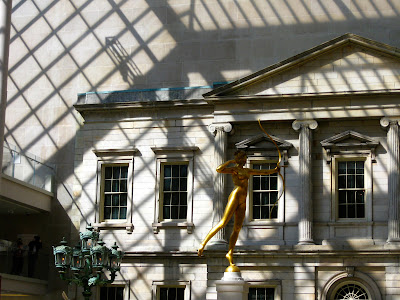 |
| Sphinx |
The other day I took a tour of one of the world’s greatest museums with my new friend, Thoman P. Campbell, who is the Director of The Metropolitan Museum of Art in New York City. Thomas is very erudite on the subject of the museum’s exhibits, and has a lovely posh English voice. No, I don’t have friends in high places, but I did have seven bucks for the audio guide. On it, I listened to ‘The Director’s Tour’, a quick-ish round-up of Thomas’s favourites from the massive collection. This is not only interesting, but extremely helpful in countering what could otherwise very easily become complete overwhelm. As Thomas says in his introduction, you could spend years in this museum and not see all its treasures.
 |
| Thomas says: "walk this way..." |
Clutching ‘The Director’s Tour’ map, and with headphones securely in place, I set out as encouraged by Thomas towards the Egyptian galleries. We viewed the Mastaba Tomb of Perneb, models from the amazing find in the Tomb of Meketre, and spent some time in the Temple of Dendur (saved from inundation by the waters of the Aswan Dam).
 |
| 'The American Wing' |
Skipping nimbly from century to century and continent to continent, Thomas whizzed me around the American Wing, where I saw impressive building facades preserved indoors, and Tiffany stained glass. Next door were full suits of armour in medieval splendour. We paused at a small ‘studiolo’ from the Ducal Palace in Gubbio, constructed of intricate wooden mosaic; then segued through a hall of medieval sculpture, tapestries and stained glass. Then it was into a wing containing rooms recreated to look like 19th century Manhattan drawing rooms, hung with Renoir, Goya, Rembrandt and Ingres.
Recreated rooms are a bit of a specialty of the Metropolitan. Passing many of them with no time for more than a glance, Thomas did insist that I pause in the ‘European Sculpture and Decorative Arts’ section to consider the Grand Salon from the Hotel de Tesse, an opulent French drawing room complete with an exquisite table made specially for Marie Antoinette.
 |
| Model from the Tomb of Meketre, Egypt. |
Then it was into the Sculpture Court, on to ‘Precolumbian Gold’, through the ‘Arts of Oceania’, and so to some pretty extraordinary African masks, sculptures and carvings. Barely catching our breath, Thomas and I continued on to Greek and Roman sculpture, finding a lavish Roman sarcophagus, a complete painted room rescued from the ash of Vesuvius, and a lovely Greek Kouros.
 |
| 'Ugolino and His Sons', Jean-Baptiste Carpeaux (1865-7) |
With the afternoon wearing on and time running short, Thomas nevertheless encouraged me up the grand staircase for at least a brief glimpse of some of the treasures on the second floor. We hurried down a gallery filled with Chinese porcelain to ‘Asian Art’, where we found a giant Bodhisattva, a gallery of early Chinese jade carvings and a lovely small statuette of a female dancer from the Han Dynasty. Around the corner was a recreated Asian garden courtyard, a dancing figure from India, another Buddha, and a gallery of Japanese decorative art, including many scrolls.
 |
| Ingres: 'Princesse de Broglie' |
Scurrying back to the head of the staircase, we were in time to squeeze in a quick look at ‘European Paintings’, including Tiepolo, El Greco, Rembrandt and several Vermeers.
Thomas and I wanted to plunge on into ‘Modern and Contemporary Art’ (they have Van Gogh, Monet and Manet in there, as well as Jackson Pollock) and ‘Art of the Arab Lands’ (a Damascus Room and a recreated Mihrab), but we were turned back sternly by a guard and told that it was closing time. Thomas’s influence was as nothing in the face of this redoubtable custodian, and so we called it quits.
For the time being.
Join Thomas and I on our walk....
Image of Thomas from:
http://topics.nytimes.com/top/reference/timestopics/people/c/thomas_p_campbell/index.html
No comments:
Post a Comment